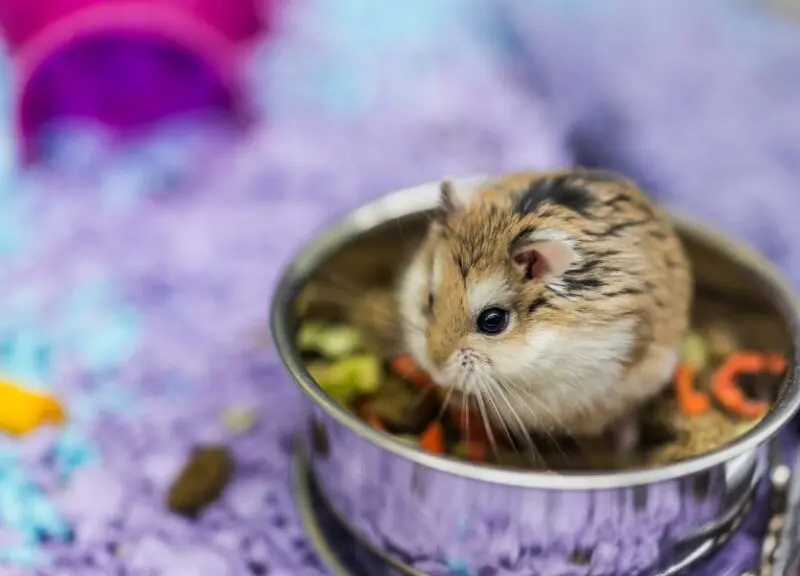Many people love to have a hamster or two as a family pet. Not only are they cute, but they are adorable when they are given a special treat to eat.
What many people don’t know is how delicate their digestives systems are and how easy it is to make your hamster ill if you feed them the wrong food.
In this article, we will go over the fruit and vegetables hamsters can eat, as well as other food suggestions for them.
Feeding Your Hamster Fresh Vegetables And Fruit?
This is a common question many people ask, but the answer is not so simple. Fresh vegetables and fruit should only be given infrequently as a special treat for your hamster and in tiny amounts each time.
Large portions of any fresh food will upset their delicate digestive systems which could make them ill.
Feeding your hamster too many veggies can lead to bloating or diarrhea and that is very unpleasant for your hamster. So you should introduce fresh food gradually.
You should watch your hamster closely whenever you add new fresh vegetables to your hamster’s diet. If they show discomfort or have a negative reaction, stop feeding them that fruit or vegetable.
The recommended servings for fresh food (from the list below) are no more than two servings per day, so one fruit/veggie and one protein/other per day for smaller breeds of hamster.
Hamsters love hiding food, and fresh items will go rotten quickly. Removing uneaten pieces on the same day they were given is necessary to keep your hamster healthy.
What Should I Feed My Hamster?
Below is a list of foods that should be fed to your hamster, and some tips on preparing them. Remember just like humans, your hamster will have a preference for the type of fresh food it likes most.
You can always create your own unique blend of what they like the most, but remember to give them a well-balanced combination that keeps your hamster happy in the tummy department.
Green Vegetables
Hamsters love fresh veggies, which offer a good balance to the dry mix they eat. Veggies are rich in vitamins and fiber, are hydrating, and serve as a tasty snack for your hamsters.
You can use your hands to tear up pieces of lettuce or other greens like collards, bok choy, kale, and spinach. Feed them separately in a dish that’s on the ground so they don’t have to jump off their wheel too much.
Here is a list of nutritious greens your hamster will enjoy.
Green Vegetables That Are Safe
- Asparagus
- artichoke
- arugula
- Beet greens
- Bok choy
- Broccoli, cabbage, red and green
- Carrots
- kale
- pumpkin
- tomatoes (without leaves as they are toxic)
- Celery
- cucumber
- mustard greens
- turnip tops
- spinach
- zucchini squash. Can be fed to your hamster in small amounts as a special treat about once or twice per week. You don’t want them eating so much that it upsets their tummy!
- Sweet potatoes (Cooked only, raw potatoes can’t be served to a hamster.)
Although iceberg lettuce is a safe option for your hamster you should avoid it. It has no nutritional value and the high water content can cause diarrhea.
Fruits
Fruits are full of nutrients, water, and are naturally high in fiber. Always remove the seeds before feeding them to your hamster because seeds can be a choking hazard for hamsters or even contain chemicals that could be lethal to them such as apple seeds.
Due to the high sugar content, hamsters should only be given fresh fruit on occasion to avoid potential diarrhea (especially when mixed with veggies) and reduce the risk of diabetes, especially for dwarf hamsters.
Important Steps Before Serving Fruit To Your Hamster
Remove Skin And Wax
Always stick to unwaxed fruits if not always wash the wax off with warm water, or carefully remove the skin of the fruit, this will remove any unsafe traces of pesticides and chemicals. Don’t forget to also remove any stickers as they are definitely not hamster food.
Remove Seeds, Stem, And Leaves
Cut and remove any seeds and stems and leaves that are harmful.
Cut Into Smaller Sizes
Cut into smaller hamster sizes for serving.
Here is a list of fruits that are safe for your hamster.
Fruits That Are Safe
- Apples, pears (remove seeds as they are lethal to your hamster)
- Bananas
- Grapes
- Papayas
- Peaches, nectarines (no stone)
- Kiwi fruit
- Mango
- Peas
- Plums (No pits)
- Pomegranate
- Starfruit
- Watermelon (seedless)
- Watercress
- Tomatoes ( Given when ripe with no seeds, stem, or leaves.)
- Dried Organic Coconut
- Figs
- Honeydew Melon
- Guava
- Dates
- Apricots
- Berries – Strawberries, Blueberries, Blackberries, Cranberries, Elderberries
- Kumquat
- Lychees (seedless)
Can You Feed Your Hamster Oranges Or Other Citrus Fruits?
No. Oranges and other citrus fruit are not safe to feed your hamster. Citrus are very acidic and not the right balance for their stomach.
Citrus fruit can cause kidney or liver problems, as well as an intestinal obstruction for your Hamster.
Proteins To Feed Your Hamster
Did you know that hamsters are omnivorous, meaning they eat a variety of proteins? This is especially important for young hamsters, which need more protein to grow than adult hamsters.
Hamsters should eat boiled or cooked protein because raw proteins contain harmful bacteria and parasites that can make them sick.
Fatty meats are to be avoided as it’s high in calories and can increase the risk of obesity, heart, liver, or kidney diseases.
The best sources of protein for hamsters are:
- Tofu (soybean curd)
- Low fat cottage cheese
- The whites of boiled eggs are suitable
- The yoke of a boiled egg may be suitable for an occasional meal
- Scrambled eggs without oil or milk are better than a solid yoke.
- Dried crickets
- Plain low-fat yogurt
- Cooked Chicken Breast (flesh only no bones or skin)
Grains, Nuts, And Seeds
Nuts are great treats for your hamster, but as with any type of food, you need to be careful what kind you give them.
Make sure the nut has been processed in such a way that it is safe for your hamster, and avoid nuts containing chemicals or those not intended for animals.
Pumpkin seeds are another option! They are a rich source of Vitamin A, which is essential for a healthy and glowing coat.
However, do take note that nuts are high in calories and fat content.
The recommended dose is to feed your hamster one nut a day or once every two to three days. Overfeeding them nuts can lead to obesity.
Here is a list of grains, nuts, and seeds you can feed your hamster.
- Bran and wheat germ
- Cooked pasta, dried
- Cooked rice, dried
- Cooked oatmeal
- Sesame seeds
- Sunflower seeds
- Pumpkin seeds
- Almonds, crushed or unpeeled (crushed is better)
- Peanuts, dry roasted and unsalted
- Walnuts, but be careful with the chemical in them.
- Pecans, but be careful not to overfeed
- Pine nuts, but be careful not to overfeed
Plants And Flowers
Hamster can also snack on plants and flowers but make sure they are safe before giving them some to snack on. The most common ones you can feed them are dandelion leaves, flowers, and hawthorn leaves.
I would recommend getting organic plants and flowers. The ones from a florist might contain dangerous traces of pesticides.
Here is a list of plants and flowers your hamster can eat.
Plants And Flowers Your Hamster Can Eat
- Bramble leaves
- Blackberry leaves
- Chickweed
- Clover
- Dandelion leaves and flowers (great for digestion)
- Hawthorn leaves
- Lemon verbena
- Mint leaf or fruit
- Nettle leaf, stalks, seed pods
- Violet stems and flowers
- Marigold
- Roses
- Sow thistle
- Sweetpeas
- Wallflowers
- watercress
- Young grass
- Millet spray
- Michaelmas daisies
Foods To Avoid Which Are Deadly To Hamster
Some foods, such as citrus foods (orange, lemon, lime, grapefruit, pineapple), can be fatal to hamsters or prove more harmful than beneficial. We strongly warn you against feeding your hamster these foods.
However, if you decide to give it a little taste, proceed with caution as too much can cause your pet to suffer chronic health problems or even worse can lead to death.
Citrus Food
As mentioned above citrus foods are fatal to your hamsters. These foods have a high level of acidity in them and your hamster’s stomach cannot handle acid. Consuming citrus foods can lead to digestive problems and diarrhea.
So you should avoid feeding your hamster citrus food and fruits that are acidic and sour. However sweet citrus is okay in tiny amounts.
Almonds
Some say that almonds are not safe for hamster consumption. The almonds we consume are known as sweet almonds (usually unblanched with brown skin intact).
They are longer and almond-shaped and safe for human and hamster consumption.
The ones to avoid are bitter almonds, they have a distinctive sweet scent, and are rounder.
Bitter almonds are not only toxic, but they can also be deadly to your hamsters.
The difference between the two is that bitter almonds contain a chemical called amygdalin which breaks down into cyanide in the stomach of an animal (including humans).
Spicy Foods, Garlic, And Onions
Spicy foods are not safe for hamsters, because they contain capsaicin.
Capsaicin is the chemical in chili peppers that makes them spicy hot. This family of hot spices includes jalapeno, cayenne, and paprika to name a few. They all cause inflammation in the form of chemical burns to their digestive system.
The heat in these foods can trigger stomach problems and diarrhea which is not what you want to happen to your pet.
Garlic and onions will also lead to a similar outcome as spicy food because they contain N-propyl disulfide, a substance that can affect the red blood cells of a hamster.
Don’t feed your hamster any spicy food such as bell peppers. These are too abrasive and acidic for your hamster’s digestive system.
Also, bell peppers don’t have any nutritional benefits, so it’s best to avoid them.
Food That Contains Salt Or Sugar
Just like us humans, salt and sugar can cause many health issues for hamsters. We recommend not feeding your little pet these foods that are high in sugar or salt as they can lead to tooth decay, obesity, and diabetes.
It’s important to check for hidden salt and sugar in your hamster treats, for example, sucrose glucose and fructose. If you are unsure if the snack is unsafe for your hamster then it’s a good idea to check through the ingredients carefully.
Munching on too many sugary foods usually leads to a sweet tooth which in turn causes them to crave sugar that is found abundantly throughout all types of desserts such as cake, cookies, ice cream, etc.
You should avoid them at all costs.
Chocolate
Can you feed your hamster chocolate?
Many people believe that hamsters cannot eat chocolate because it can result in death.
However, this is not true as most of the time they will just get diarrhea and you might have to give them a laxative.
Chocolate has minimal effects on your hamster if fed with caution but remember if you feed it too much it can be fatal.
We advise against feeding your hamster too much chocolate as it is not a healthy snack for them and cocoa beans have an alarmingly high level of theobromine, which is toxic to humans but harmless to hamsters.
Avocado
According to research, avocado flesh is safe for your hamster to eat, but the skin or pit is not.
Avocados are a good source of vitamin C and healthy fats for your hamsters to consume.
You should also avoid feeding them avocado too often as it can result in weight gain or other health problems.
Avocado contains high levels of fat that will lead to obesity over time.
Conclusion
Hamsters should avoid eating spicy foods, citrus fruits, and any other food with high acidity.
A diet of fresh vegetables is recommended for these furry critters as it will provide them with the nutrients they need to stay healthy while enjoying their favorite treats in moderation.
Remember when you were younger and your parents told you not to eat too much candy?
You can use this same principle on hamsters by feeding them fruit in limited quantities.
The key here is to make sure there’s always more nutritious food available so that your little friend never feels deprived of all those delicious sugar-filled goodies!























